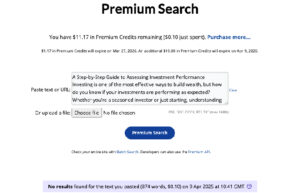Investing is one of the most effective ways to build wealth, but how do you know if your investments are performing as expected? Whether you’re a seasoned investor or just starting, understanding how to assess investment performance is crucial for making informed decisions. By tracking your investments’ performance, you can better align your portfolio with your financial goals and make adjustments when necessary.
Table of Contents
Understanding Investment Goals and Benchmarks
Before assessing investment performance, define your goals—whether it’s capital growth, steady income, or a mix of both. Your goals determine the types of investments you choose, and understanding your risk tolerance is key. For example, aggressive growth may involve more volatile assets like stocks, while income-focused investments may lean toward stable options like bonds or dividend stocks.
Once goals are set, select appropriate benchmarks for comparison. Benchmarks, such as the S&P 500 for U.S. stocks, help evaluate how your investments perform relative to the broader market or sector, allowing you to assess whether you’re meeting your objectives.
Rate of Return (RoR): The Core Metric for Investment Performance
The rate of return (RoR) measures how much an investment has gained or lost over a specific period, expressed as a percentage of the initial investment.
RoR variations include:
- Absolute Return: Total return over a period, not accounting for compounding or market cycles.
- Annualized Return: Adjusted for compounding, showing the average annual return.
- Real vs. Nominal Return: Nominal return is unadjusted for inflation, while real return subtracts inflation for a more accurate picture of growth.
Factors influencing RoR include market conditions, economic cycles, and your investment strategy. To interpret RoR, compare it to your goals and benchmarks—what might be a good return for one investor may not be for another.
Risk-Adjusted Return: Beyond Just RoR
RoR is important, but doesn’t account for risk. High returns often come with high risk, and risk-adjusted return metrics help evaluate how much return you’re earning relative to the risk taken.
Key risk-adjusted metrics include:
- Sharpe Ratio: Measures return compared to volatility; a higher ratio indicates better risk-adjusted returns.
- Alpha: Shows how an investment performs relative to its benchmark—positive alpha means outperformance, negative alpha means underperformance.
- Beta: Measures an investment’s volatility relative to the market; a beta above 1 indicates higher risk.
When comparing investments with different risks, risk-adjusted returns are essential. An investment with a higher Sharpe ratio may be more suitable for risk-averse investors, even if both have the same RoR.
Analyzing the Time Horizon and Compounding Effects
Time is crucial in assessing investment performance. Short-term fluctuations may not reflect an investment’s true potential, with long-term performance offering a clearer picture of alignment with goals.
Compounding enhances returns over time, as reinvested earnings generate additional growth. The longer the investment period, the greater the compounding effect, making long-term investing a key strategy for wealth building.
Evaluating performance across different time frames—annual, quarterly, or monthly—helps capture growth trends and volatility, ensuring you’re not swayed by short-term market movements.
The Importance of Diversification in Performance Assessment
Diversification reduces risk by spreading investments across different asset classes, industries, and regions, helping to offset poor performance in one area with better performance in another.
While evaluating individual assets is important, assessing overall portfolio performance is key. A balanced mix of high- and low-risk assets helps manage volatility.
Regularly rebalancing your portfolio ensures it aligns with your goals and risk tolerance, optimizing performance by maintaining a balanced risk-return profile.
Accounting for Fees, Taxes, and Inflation
Investment fees, such as management and trading fees, can significantly reduce long-term returns. Even small fees, like 1%, can erode portfolio growth over time.
Taxes on capital gains and dividends also impact net returns, making it crucial to consider their effects during performance evaluation. Tax-advantaged accounts can help reduce tax burdens.
Inflation reduces the purchasing power of returns. To accurately assess performance, adjust returns for inflation to determine if the investment is truly growing or just keeping pace with rising costs.
Evaluating Performance Reports and Statements
Investment statements provide key insights into your portfolio’s performance, including returns, dividends, asset allocation, and fees. Understanding these metrics helps assess if your investment is on track.
Look for red flags in reports, such as inconsistent performance, high fees, or significant benchmark deviations, which may signal issues with your investments.
Various tools and software can help track and analyze performance, offering real-time data to keep you informed and enable timely adjustments.
Conclusion
Understanding how to assess investment performance is vital for achieving long-term financial success. By considering metrics such as rate of return, risk-adjusted return, and portfolio diversification, you can gain a clearer picture of how your investments are performing and make more informed decisions.
Regularly evaluating your investments and accounting for fees, taxes, and inflation ensures that you’re not misled by short-term fluctuations or hidden costs. To stay ahead, make sure to adjust your strategy as needed, and remember that a well-rounded approach to performance assessment will yield better results in the long run.
For further guidance on investment strategies and performance tracking tools, click here now to learn more.

